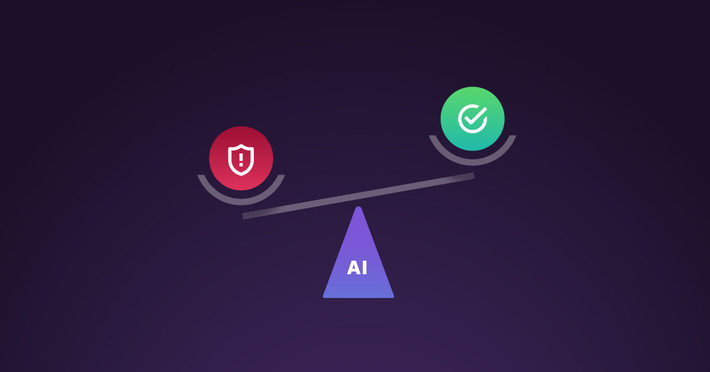
Source: Google
Artificial intelligence is among the most talked-about trends in recent years, and It is a 2 side blade with positives and negatives. Talking about positives, technologies are starting to improve our lives in multiple ways, from enhancing the healthcare experience, shopping and also making the businesses undeniable.
According to Statista, The market research firm IDC projected that the global AI market would reach a size of over half a trillion U.S. dollars by 2024. It is obvious to say that AI has a long way to go and benefit the industry with its brilliance.
Yet AI can be beneficial for all industries, but it can also give rise to unwanted threats and serious consequences. In this article, I will be discussing some of the problems that AI can cause in the future, or someone might misuse it in different ways.
Let’s dive into that without killing much time:
1. Data misuse
Ingesting, linking, sorting, and using data properly has become a lot difficult as disorganized data being ingested from sources such as the web, sensors, mobile devices, and the IoT has increased.
All the information coming from the data can cause threats or problems. Victims can easily fall into the pitfalls created by threatening them about revealing their hidden data or sensitive information to the world. A lot of scams can happen by using this technology and develop nuisances in the world.
To solve this issue, AI has made several AI Tools that can help in reducing and eliminating data misuse:
- AI in EndPoint Data Protection
- AI in protecting the privacy
- AI-powered data protection solution
- AI in Protection Data from phishing and social Engineering
- AI in the protection of data from Malware/Ransomware/APTs
2. Safety Problem
Experts like Elon Musk, Bill Gates, and Stephen Hawking have already warned and are concerned about safety and asked to pay attention to its safety issues.
There are various instances where AI has gone wrong; for example, Facebook AI bots started interacting with each other in a language no one else would understand, leading to the project shut down.
There are possibilities in which they can harm humankind, and in the case of autonomous weapons, they can be programmed to kill other humans.
There are few things that need to be taken care of:
- We need to have strong regulations, especially when it comes to the creation or experimentation of Autonomous weapons
- Global Cooperation on such kinds of weapons is required to ensure no one gets involved in the rat race.
- Complete transparency in the system where such technologies have experimented is essential to ensure its safe usage.
3. Interaction issues
The interface between machines and people is another critical risk area. Among the most evident are challenges in automated transportation, infrastructure systems, and manufacturing.
Accidents and injuries are possible if operatives of heavy equipment, vehicles, or other machinery do not understand when systems should be overridden or if they are late to override them because the operator’s attention is elsewhere – a clear possibility in applications such as autonomous cars.
In contrast, human intelligence can also be defective in prioritizing the results of the system. Behind the pictures, in the data analysis organization, script errors, data management failures, and errors in judgment in model training data can easily compromise fairness, privacy, security, and safety compliance.
Accidents caused by AI Autonomous cars are mainly due to lack of data given to them, AI performs well when it is served with a lot of informative data, which helps them become more decision-making.
4. AI Models Misbehaving
AI models themselves can cause many problems when they provide biased results ( which can occur, for example, if a population is underrepresented in the data used to train the AI model).
They become unstable, or they draw outcomes for which there is no Actionable recourse for those influenced by your decisions (such as someone who was refused a loan without knowing what they could do to change the decision).
Consider, for example, the potential for artificial intelligence models to accidentally discriminate against defended classes and other groups by combining zip code and income data to create targeted offers.
Harder to spot are cases where AI models lurk in software-as-a-service (SaaS) offerings. When merchants introduce intelligent new features, often with little fanfare, they are also proposing models that could communicate with data on the user’s system to generate unexpected risks, even lead to hidden vulnerabilities that hackers could exploit.
The assumption is that leaders who think they are protected if their organization has not purchased or built artificial intelligence systems or are only experimenting with their implementation could be wrong.
You can control the AI models by applying the following things:
- Transparency and Interpretability
- Feature Engineering
- Quality Control
- Hyperparameters
- Model Bias
- Model governance
After deploying the data into your Machine Learning Application, it is beneficial to review and reinforce your model for sustaining the changes in environments, data, and actors. And this is very important in moderating the risk associated with ML.
Conclusion
All the things listed above can be hazardous for humankind, as many AI models can misbehave or be programmed to harm humans. To be secure and safe, try to develop AI solutions better and always try to benefit the world and make the world better.
Author Bio: Ved Raj is the business analyst at ValueCoders (https://www.valuecoders.com/), Which provides consulting and AI-based solutions to high-tech companies in the tech and digital industries.
